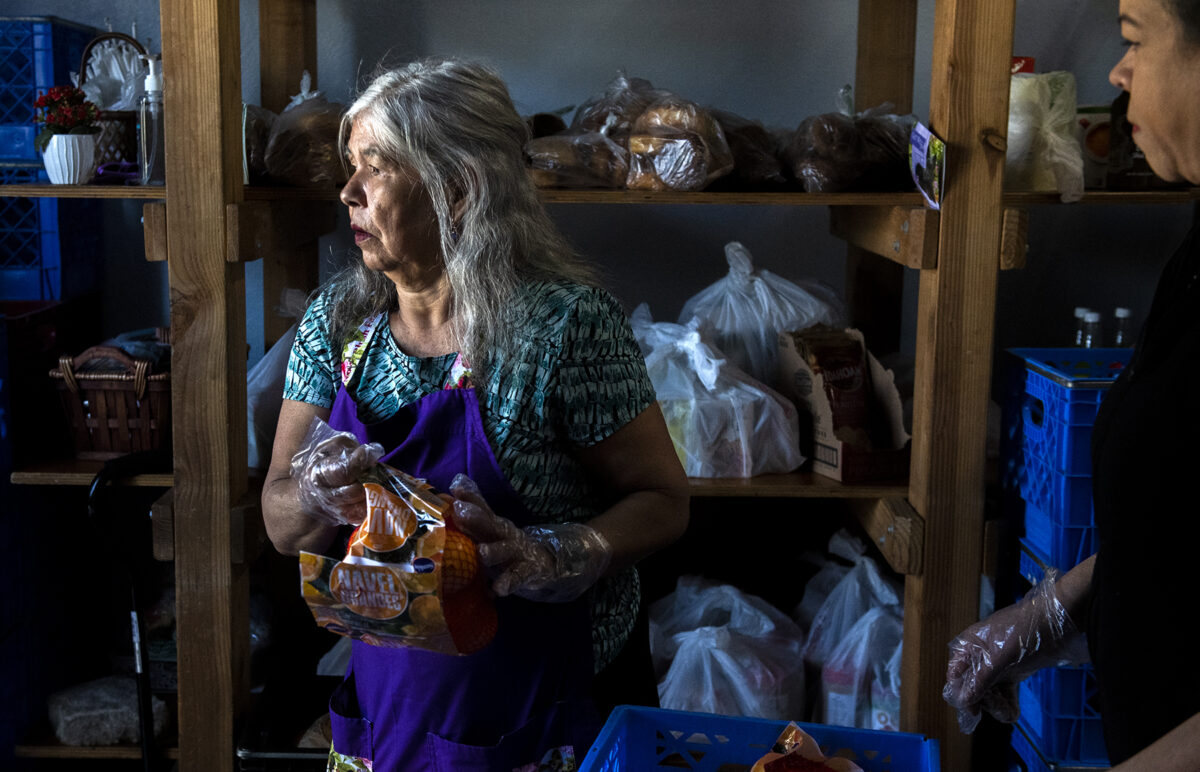With the state no longer providing extra pandemic food aid, Long Beach area food banks are getting ready for a spike in demand for the canned goods, frozen meat and fresh produce they give out daily to hungry families.
“There’s a confluence of things that are happening right now that are contributing to an increased need for supplemental food,” including the end of extra eviction protections for renters, food prices driven higher by inflation and the lapsing of an emergency boost to CalFresh benefits, said Emily Kazim, executive director of the Long Beach Center for Economic Inclusion.
The center operates its own food bank and supports a network of 10 other sites that distribute food to those in need.
“If our numbers aren’t increasing, it’s because we do not have extra food to give people,” Kazim said.

CalFresh is the state’s moniker for the federally-funded Supplemental Nutrition Assistance Program (SNAP), which some just call food stamps. It provides debit cards lower-income families can use to buy pantry staples, meat, milk, eggs and fresh produce.
As COVID-19 began sweeping the country in March 2020, leaving a wake of closed businesses and lost income, Congress approved extra benefits to keep Americans from going hungry.
In January 2023, nearly 945,000 households in Los Angeles County were receiving CalFresh benefits, according to the state Department of Social Services. (The agency was not able to provide specific data for Long Beach as of Friday.)
With pandemic emergency declarations now expiring, the last boost to benefits—tens or hundreds of dollars a month for most families— was distributed March 26. Now food providers are starting to see trickles that they worry will become a flood of people needing help to keep food on their tables.
Christian Outreach in Action (an East Village-based nonprofit that provides hot meals daily, a twice-weekly food pantry and clothing distribution once a week) typically serves up to 1,000 people a day but has been seeing 75 to 100 more than that in the past couple weeks, Executive Director Dixie Dohrmann said.
It’s too early to know how the loss of extra pandemic aid will play out, she said, but “we’re definitely seeing an incremental (increase), and we anticipate much larger.”
At Lutheran Social Services in the Washington neighborhood, people were lined up Thursday morning for food distribution. After adding their names to a sign-in sheet, they took their bags and folding shopping carts to the back of the building, where volunteers bustled around a garage-like space gathering produce, canned food, frozen chicken and bunches of cut flowers that would otherwise have gone to a landfill or compost heap.
Maria Hernandez—who started volunteering at Lutheran Social Services decades ago in gratitude for the help she received as a new immigrant with three children to feed—said meat, milk and eggs are always in demand, but people also get excited when fresh vegetables are available.
She’s been seeing new faces lately, and an overall increase in the number of people coming through the line, she said.
One of them on Thursday was Monie Alvarez, who said she gets CalFresh benefits, but “it’s not enough.” Sometimes, she said, she doesn’t have any place to cook so she has to buy prepared foods, which cost more.
Judith Carrillo, who said she’s lived in Long Beach for 23 years, was there to supplement her benefits so she can feed a family of five, including three hungry kids.

With chicken, rice, vegetables and oranges in her cart, “it’s very good today,” she said.
Lutheran Social Services Emergency Services Program Manager Wendy Rubio said some of their food bank patrons have expressed concern about how they’ll manage without the extra benefit they’ve been getting for the past three years.
“With the cost of food really going up, they were barely making it,” she said.
It’s the same story across the state, and other states that ended their emergency benefits earlier have already seen more demand at food banks, said Becky Silva, director of government relations for the California Association of Food Banks, a nonprofit with 41 member pantries that lobbies for hunger-fighting resources and policies.
The association is backing a bill that would raise the minimum CalFresh allotment from $23 a month to $50, and it is advocating for more state funding for a program that helps pantries buy food grown in California, Silva said.
The Long Beach Center for Economic Inclusion’s Kazim said food providers already are dealing with a decrease in state and federal funding, and grants from nonprofits such as the United Way are on the decline as well.
“We’re going to need to get really creative in how we get this food to people who need it,” she said.

Where to find food
A list of Long Beach food banks with hours and locations, as well as places to get clothing and hot meals, is available on the city’s website here.
The Long Beach Center for Economic Inclusion has information on the food pantries it supports and how to help on its website.

